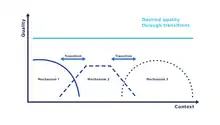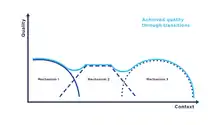Transition (computer science)
Transition refers to a computer science paradigm in the context of communication systems which describes the change of communication mechanisms, i.e., functions of a communication system, in particular, service and protocol components. In a transition, communication mechanisms within a system are replaced by functionally comparable mechanisms with the aim to ensure the highest possible quality, e.g., as captured by the quality of service.

Idea and functional principle

Transitions enable communication systems to adapt to changing conditions during runtime. This change in conditions can, for example, be a rapid increase in the load on a certain service that may be caused, e.g., by large gatherings of people with mobile devices. A transition often impacts multiple mechanisms at different communication layers of a layered architecture.
Mechanisms are given as conceptual elements of a networked communication system and are linked to specific functional units, for example, as a service or protocol component. In some cases, a mechanism can also comprise an entire protocol. For example on the transmission layer, LTE can be regarded as such a mechanism. Following this definition, there exist numerous communication mechanisms that are partly equivalent in their basic functionality, such as Wi-Fi, Bluetooth and ZigBee for local wireless networks and UMTS and LTE for broadband wireless connections. For example, LTE and Wi-Fi have equivalent basic functionality, but they are technologically significantly different in their design and operation. Mechanisms affected by transitions are often components of a protocol or service. For example, in case of video streaming/transmission, the use of different video data encoding can be carried out depending on the available data transmission rate. These changes are controlled and implemented by transitions; A research example is a context-aware video adaptation service to support mobile video applications.[1] Through analyzing the current processes in a communication system, it is possible to determine which transitions need to be executed at which communication layer in order to meet the quality requirements. In order for communication systems to adapt to the respective framework conditions, architectural approaches of self-organizing, adaptive systems can be used, such as the MAPE cycle [2] (Monitor-Analyze-Plan-Execute). This central concept of Autonomic Computing can be used to determine the state of the communication system, to analyze the monitoring data and to plan and execute the necessary transition(s). A central goal is that users do not consciously perceive a transition while running applications and that the functionality of the used services is perceived as smooth and fluid.
Recent research
The study of new and fundamental design methods, models and techniques that enable automated, coordinated and cross-layer transitions between functionally similar mechanisms within a communication system is the main goal of a collaborative research center funded by the German research foundation (DFG). The DFG collaborative research center 1053 MAKI - Multi-mechanism Adaptation for the future Internet - focuses on research questions in the following areas: (i) Fundamental research on transition methods, (ii) Techniques for adapting transition-capable communication systems on the basis of achieved and targeted quality, and (iii) specific and exemplary transitions in communication systems as regarded from different technical perspectives.
A formalization of the concept of transitions that captures the features and relations within a communication system to express and optimize the decision making process that is associated with such a system is given in.[3] The associated building blocks comprise (i) Dynamic Software Product Lines, (ii) Markov Decision Processes and (iii) Utility Design. While Dynamic Software Product Lines provide a method to concisely capture a large configuration space and to specify run time variability of adaptive systems, Markov Decision Processes provide a mathematical tool to define and plan transitions between available communication mechanisms. Finally, utility functions quantify the performance of individual configurations of the transition-based communication system and provide the means to optimize the performance in such a system.
Applications of the idea of transitions have found their way to wireless sensor networks[4] and mobile networks,[5] distributed reactive programming,[6][7] WiFi firmware modification,[8] planning of autonomic computing systems,[9] analysis of CDNs,[10] flexible extensions of the ISO OSI stack,[11] 5G mmWave vehicular communications,[12][13] the analysis of MapReduce-like parallel systems,[14] scheduling of Multipath TCP,[15] adaptivity for beam training in 802.11ad,[16] operator placement in dynamic user environments,[17] DASH video player analysis,[18] adaptive bitrate streaming[19] and complex event processing on mobile devices.[20]
References
- S. Wilk, D. Stohr, and W. Effelsberg. 2016. A Content-Aware Video Adaptation Service to Support Mobile Video. ACM Trans. Multimedia Comput. Commun. Appl. 12, 5s, Article 82 (November 2016)
- JO Kephart and DM Chess. The vision of autonomous computing. IEEE Computer, 1, pp. 41-50, 2003.
- Alt, Bastian; Weckesser, Markus; et al. (2019). "Transitions: A Protocol-Independent View of the Future Internet". Proceedings of the IEEE. 107 (4): 835–846. doi:10.1109/JPROC.2019.2895964. ISSN 0018-9219.
- Kluge, Roland; Stein, Michael; Giessing, David; Schürr, Andy; Mühlhäuser, Max (2017). Anjorin, Anthony; Espinoza, Huáscar (eds.). "cMoflon: Model-Driven Generation of Embedded C Code for Wireless Sensor Networks". Modelling Foundations and Applications. Lecture Notes in Computer Science. Springer International Publishing. 10376: 109–125. doi:10.1007/978-3-319-61482-3_7. ISBN 9783319614823.
- Richerzhagen, N.; Richerzhagen, B.; Hark, R.; Stingl, D.; Steinmetz, R. (2016). "Limiting the Footprint of Monitoring in Dynamic Scenarios through Multi-Dimensional Offloading". 2016 25th International Conference on Computer Communication and Networks (ICCCN): 1–9. doi:10.1109/ICCCN.2016.7568539. ISBN 978-1-5090-2279-3.
- Mogk, Ragnar; Baumgärtner, Lars; Salvaneschi, Guido; Freisleben, Bernd; Mezini, Mira (2018). "Fault-tolerant Distributed Reactive Programming". Schloss Dagstuhl - Leibniz-Zentrum für Informatik GMBH, Wadern/Saarbruecken, Germany. doi:10.4230/lipics.ecoop.2018.1.
- Margara, A.; Salvaneschi, G. (2018). "On the Semantics of Distributed Reactive Programming: The Cost of Consistency". IEEE Transactions on Software Engineering. 44 (7): 689–711. doi:10.1109/TSE.2018.2833109. ISSN 0098-5589.
- Schulz, Matthias; Wegemer, Daniel; Hollick, Matthias (2018-09-01). "The Nexmon firmware analysis and modification framework: Empowering researchers to enhance Wi-Fi devices". Computer Communications. 129: 269–285. doi:10.1016/j.comcom.2018.05.015. ISSN 0140-3664.
- Pfannemueller, M.; Krupitzer, C.; Weckesser, M.; Becker, C. (2017). "A Dynamic Software Product Line Approach for Adaptation Planning in Autonomic Computing Systems". 2017 IEEE International Conference on Autonomic Computing (ICAC): 247–254. doi:10.1109/ICAC.2017.18. ISBN 978-1-5386-1762-5.
- Jeremias Blendin, Fabrice Bendfeldt, Ingmar Poese, Boris Koldehofe, and Oliver Hohlfeld. 2018. Dissecting Apple's Meta-CDN during an iOS Update. In Proceedings of the Internet Measurement Conference 2018 (IMC '18). ACM
- Heuschkel, J.; Wang, L.; Fleckstein, E.; Ofenloch, M.; Blöcher, M.; Crowcroft, J.; Mühlhäuser, M. (2018). "VirtualStack: Flexible Cross-layer Optimization via Network Protocol Virtualization". 2018 IEEE 43rd Conference on Local Computer Networks (LCN): 519–526. doi:10.1109/LCN.2018.8638106. ISBN 978-1-5386-4413-3.
- Asadi, A.; Müller, S.; Sim, G. H.; Klein, A.; Hollick, M. (2018). "FML: Fast Machine Learning for 5G mmWave Vehicular Communications". IEEE INFOCOM 2018 - IEEE Conference on Computer Communications: 1961–1969. doi:10.1109/INFOCOM.2018.8485876. ISBN 978-1-5386-4128-6.
- Sim, G. H.; Klos, S.; Asadi, A.; Klein, A.; Hollick, M. (2018). "An Online Context-Aware Machine Learning Algorithm for 5G mmWave Vehicular Communications". IEEE/ACM Transactions on Networking. 26 (6): 2487–2500. doi:10.1109/TNET.2018.2869244. ISSN 1063-6692.
- KhudaBukhsh, W. R.; Rizk, A.; Frömmgen, A.; Koeppl, H. (2017). "Optimizing stochastic scheduling in fork-join queueing models: Bounds and applications". IEEE INFOCOM 2017 - IEEE Conference on Computer Communications: 1–9. arXiv:1612.05486. doi:10.1109/INFOCOM.2017.8057013. ISBN 978-1-5090-5336-0.
- Frömmgen, Alexander; Rizk, Amr; Erbshäußer, Tobias; Weller, Max; Koldehofe, Boris; Buchmann, Alejandro; Steinmetz, Ralf (2017). "A Programming Model for Application-defined Multipath TCP Scheduling". Proceedings of the 18th ACM/IFIP/USENIX Middleware Conference. Middleware '17. New York, NY, USA: ACM: 134–146. doi:10.1145/3135974.3135979. ISBN 9781450347204.
- Palacios, Joan; Steinmetzer, Daniel; Loch, Adrian; Hollick, Matthias; Widmer, Joerg (2018). "Adaptive Codebook Optimization for Beam Training on Off-the-Shelf IEEE 802.11Ad Devices". Proceedings of the 24th Annual International Conference on Mobile Computing and Networking. MobiCom '18. New York, NY, USA: ACM: 241–255. doi:10.1145/3241539.3241576. ISBN 9781450359030.
- Luthra, Manisha; Koldehofe, Boris; Weisenburger, Pascal; Salvaneschi, Guido; Arif, Raheel (2018). "TCEP". Proceedings of the 12th ACM International Conference on Distributed and Event-based Systems - DEBS '18. New York, New York, USA: ACM Press: 136–147. doi:10.1145/3210284.3210292. ISBN 9781450357821.
- Stohr, Denny; Frömmgen, Alexander; Rizk, Amr; Zink, Michael; Steinmetz, Ralf; Effelsberg, Wolfgang (2017). "Where Are the Sweet Spots?: A Systematic Approach to Reproducible DASH Player Comparisons". Proceedings of the 25th ACM International Conference on Multimedia. MM '17. New York, NY, USA: ACM: 1113–1121. doi:10.1145/3123266.3123426. ISBN 9781450349062.
- Rizk, Amr; Koeppl, Heinz; Steinmetz, Ralf; Ballard, Trevor; Alt, Bastian (2019-01-17). "CBA: Contextual Quality Adaptation for Adaptive Bitrate Video Streaming (Extended Version)". arXiv:1901.05712 [cs.MM].
- Graubner, Pablo; Thelen, Christoph; Körber, Michael; Sterz, Artur; Salvaneschi, Guido; Mezini, Mira; Seeger, Bernhard; Freisleben, Bernd (2018). "Multimodal Complex Event Processing on Mobile Devices". Proceedings of the 12th ACM International Conference on Distributed and Event-based Systems. DEBS '18. New York, NY, USA: ACM: 112–123. doi:10.1145/3210284.3210289. ISBN 9781450357821.